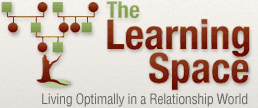The Learning Space Blog
Resilience in the Family - Resilience in the Brain
the following is the presentation Regina gave at the recent Resiliency in the Family & the Brain learning forum...
In my work with individuals and families, people will often report a lack of contact with important but difficult members of their family. They will say, ‘that person is really difficult, dysfunctional, mean, toxic, damaging, hurtful or simply annoying” as though this is an acceptable and sufficient reason to “not have a relationship.” When they talk about this person, usually a parent, a child, a sibling, a quirky aunt or a dangerous cousin, there is typically a lot of emotion. The reactivity is also evident in the data on the Zengar equipment. Most of us have people in our families or extended families that we avoid, purposely don’t have contact with or don’t even know about. Some families have more of these relationship gaps in their system than others or wish they had more of these gaps.
In my work observing families, I believe that there is a direct relationship between this anxiously driven distancing or flat out cutting off and one’s physical and emotional health and well being. I also believe that there are false emotional assumptions about the benefits of being distant.
One assumption is that family relationships can end. I believe they do not. Even when there is no contact, they live on in the memories, brain and cellular experiences of all individuals in the relationship system. The shear energy alone that folks use to maintain distance is evidence that the relationship lives on. The lingering pain, anger, frustration and resentments are also evidence that the relationship continues to have an effect. Pretending a relationship doesn’t exist when it continues to live on in one’s brain and body contributes to the development of physical and emotional problems.
The other challenge with cutting off from important others is that all the responsibility for how one participates in the relationship is given to the most anxious person in the system. It is a giving up of autonomy over self to fear and anxiety as it manifests in the poor behavior of the other person. It is a reactive position vs. a calm position. If one needs a cutoff to feel better, then one isn’t truly better.
People come into my practice with specific complaints such as migraines, chronic pain, anxiety, insomnia, work problems, depression and relationship dilemmas.
The following is a list of what I observe people gain for themselves when they combine neurofeedback with work on themselves in their families.
First, a broader range of emotional experiences in current relationships. What do I mean by this? Folks commonly report that they are calmer in responding to others and that they have more conscious choice. Instead of always hopping on the angry train or the blame train when they experience discomfort, folks can choose to focus on their feelings as information and decide how they might manage a negative reaction more thoughtfully. Out of that effort, people develop the capacity for more positive emotional experiences.
Second, a more realistic vs. reactive understanding of self and others. By this, I mean that people become more aware of and focused on the facts that drive them and others vs just their feelings about themselves and others. Being more factual about oneself reduces unrealistic expectations about how others should behave. For example,
Third, an ability to face and learn from the unique patterns of anxiety as it has traveled through the family system over generations. The knowledge about self and others that one gains in working out at the family emotional gym can be life saving.
Fourth, more knowledge and awareness of assumptions that drive thinking and behavior in important relationships. We all inherit emotional patterns that are mostly out of awareness but inform the way we look at self and others. For example, one common emotional assumption is that pleasing others is essential to feeling or being safe and keeping an important relationship stable. The more we see these assumptions, the more we have autonomy over their influence.
Fifth, engaging difficult relationships provides the opportunity to practice neutrality and to practice staying in charge of self under pressure. Ultimately, this lifelong practice generates resilience.
Finally, I observe that neurofeedback helps people to bridge the gap between the instinct to disconnect and the instinct to connect. It provides information that helps reduce cellular reactivity to threat, as bound up in cutoffs, long enough to engage and even benefit from difficult relationships.
Filed under Neurofeedback, Bowen family systems theory
Blog Categories
Blog Archive
- June 2019
- December 2018
- October 2018
- June 2017
- February 2017
- July 2016
- February 2016
- November 2015
- August 2015
- June 2015
- April 2015
- February 2015
- December 2014
- October 2014
- September 2014
- August 2014
- July 2014
- June 2014
- May 2014
- April 2014
- March 2014
- December 2013
- October 2013
- August 2013
- July 2013
- June 2013
- April 2013
- February 2013
- January 2013
- December 2012
- August 2012
- July 2012
- June 2012
- March 2012
- February 2012
- January 2012
- December 2011
- November 2011
- October 2011
- September 2011
- August 2011
- July 2011
- June 2011
- May 2011
- March 2011
- January 2011
- December 2010
- November 2010
- October 2010
- September 2010
- May 2010
About the Learning Space
"The Learning Space is a creative, energetic thinking space for individuals striving to live optimally in all their most important relationships. The Learning Space provides a conceptual space—a place to consider and experience alternate ways of relating."
Read More »
Upcoming Events
view events »Newsletter
Fill out the form below to subscribe to The Learning Space's quarterly newsletter, and get exclusive invitations to special learning forums and other events.

